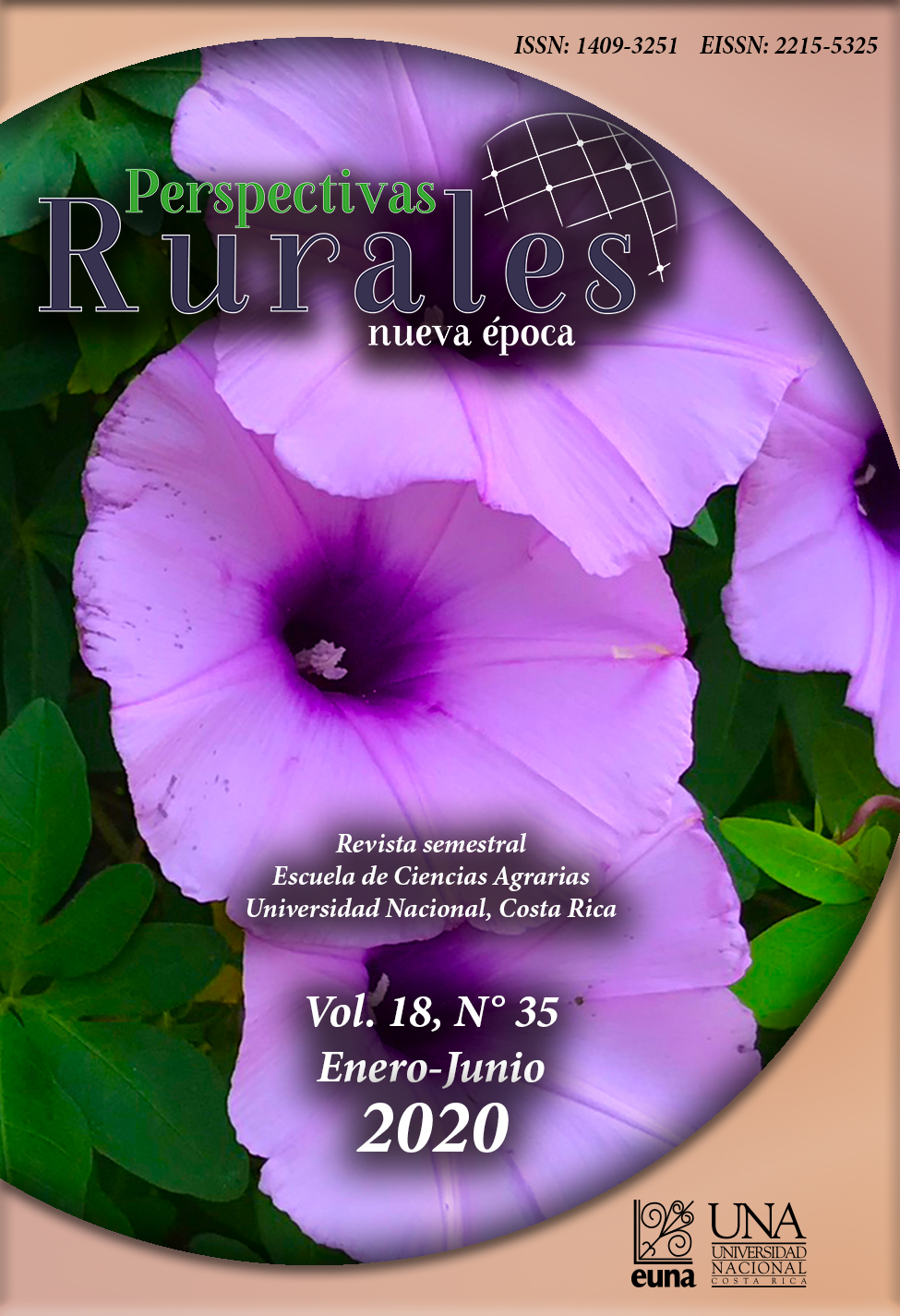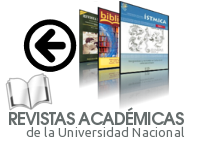Evaluación de propiedades fisicoquímicas del frijol costarricense (Phaseolus vulgaris) como estrategia de diferenciación y valorización
DOI:
https://doi.org/10.15359/prne.18-35.2Palabras clave:
Calidad, diferenciación, mercado, producto local, seguridad alimentariaResumen
Debido a los cambios en patrones de consumo orientados a reconocer atributos de productos locales y diferenciados, el presente estudio tuvo como objetivo evaluar variedades de frijol costarricense con la finalidad de identificar sus propiedades que permitan una mejor valoración y diferenciación dentro del mercado nacional. Se realizó un análisis proximal, fenólico, físico y de calidad e impurezas. Los análisis fueron realizados en el año 2018 en laboratorios de la Universidad Nacional, Costa Rica y el Laboratorio de Calidad e Inocuidad del Consejo Nacional de Producción (CNP). Entre los resultados obtenidos sobresalió la variedad Guaimí (proveniente de Upala) la cual presentó menor dureza, por tanto, podría necesitar menor tiempo de cocción para alcanzar la textura óptima, así como conservar mejor valor textural como sus propiedades funcionales. De forma general, se obtuvieron valores relevantes de proteína en rangos de 16 a 27 %, de fibra de 3 a 7 %, de extracto etéreo de 3 a 7 % y de cenizas de 4 a 6 %. Los resultados del estudio podrían ser un punto de partida para definir la funcionalidad de cada variedad de frijol de con sus propiedades físicas y químicas.
Referencias
Besancon, P. (1978). La valeur nutritionnelle des 16gumes et des prot6ines de 16gumineuses. Rev. Fr. Diet., 84, 5-17.
Brick, M. A. y Thompson, H. J. (2016). Toward closing the dietary fiber gap: candidate genes associated with dietary fiber content in common bean. The FASEB Journal, 30(1_supplement), 421-8.
Barkin, D. (2001). Superando el paradigma neoliberal: Desarrollo popular sustentable. En ¿Una nueva realidad en América Latina? (pp. 81–99). CLACSO. http://biblioteca.clacso.edu.ar/clacso/gt/20100929012426/6barkin.pdf
Campos-Vega, R., Reynoso-Camacho, R., Pedraza-Aboytes, G., Acosta-Gallegos, J. A., Guzman-Maldonado, S. H., Paredes-Lopez, O. y Loarca-Piña, G. (2009). Chemical composition and in vitro polysaccharide fermentation of different beans (Phaseolus vulgaris L.). Journal of Food science, 74(7), T59-T65.
Chidananda, K. P., Chelladurai, V., Jayas, D. S., Alagusundaram, K., White, N. D. G. y Fields, P. G. (2014). Respiration of pulses stored under different storage conditions. Journal of Stored Products Research. https://doi.org/10.1016/j.jspr.2014.04.006
de Almeida Costa, G. E., da Silva Queiroz-Monici, K., Reis, S. M. P. M. y de Oliveira, A. C. (2006). Chemical composition, dietary fibre and resistant starch contents of raw and cooked pea, common bean, chickpea and lentil legumes. Food chemistry, 94(3), 327-330.
Díaz-Batalla, L., Widholm, J. M., Fahey, G. C., Castaño-Tostado, E. y Paredes-López, O. (2006). Chemical components with health implications in wild and cultivated Mexican common bean seeds (Phaseolus vulgaris L.). Journal of Agricultural and Food Chemistry, 54(6), 2045–2052. https://doi.org/10.1021/jf051706l
Ferreira, C. D., Ziegler, V., Lindemann, I. da S., Hoffmann, J. F., Vanier, N. L. y Oliveira, M. de. (2018). Quality of black beans as a function of long-term storage and moldy development: Chemical and functional properties of flour and isolated protein. Food Chemistry, 246, 473–480. https://doi.org/10.1016/J.FOODCHEM.2017.11.118
Grunert, K. G. (2005). Food quality and safety: Consumer perception and demand. European Review of Agricultural Economics, 32(3), 369–391. 10.1093/eurrag/jbi011
Hernández-Hernández, C., Viera-Alcaide, I., Morales-Sillero, A. M., Fernández-Bolaños, J., y Rodríguez-Gutiérrez, G. (2018). Bioactive compounds in Mexican genotypes of cocoa cotyledon and husk. Food Chemistry. https://doi.org/10.1016/j.foodchem.2017.08.018
Jacinto-Hernández, C. y Campos-Escuerdo, A. (2016). Efecto de la cocción sobre algunas características nutricionales del frijol. Agronomía Mesoamericana, 4(l), 42. https://doi.org/10.15517/am.v4i0.25165
Kaur, S., Singh, N., Sodhi, N. S. y Rana, J. C. (2009). Diversity in properties of seed and flour of kidney bean germplasm. Food Chemistry, 117, 282–289.
Koehler, H. H., Iung-Hsia Chang, C. H., Scheier, G. y Burke, D. W. (1987). Nutrition composition, protein quality and sensory properties of thirty-six cultivars of dry beans ( Phaseolus vulgaris). J. Food Sci., 52, 1335-40.
Luna-Vital, D. A., Ramírez-Jiménez, A. K., Gaytan-Martinez, M., Mojica, L. y Loarca-Piña, G. (2017). Biological Effect of Antioxidant Fiber from Common Beans (Phaseolus vulgaris L.). En Dietary Fiber Functionality in Food and Nutraceuticals: From Plant to Gut (pp. 95-122).
Meiners, C. R., Derise, N. L., Lau, H. C., Crews, M. G., Ritchey, S. J. y Murphy, E. W. (1976). Proximate composition and yield of raw and cooked mature dry legumes. J. Agric. Food Chem., 24, 1122 6.
Ministerio de Agricultura y Ganadería (MAG). (2007). Caracterización y plan de acción para el desarrollo de la agrocadena de frijol (Phaseolus vulgaris) en la región Huetar Norte. Autor.
Ortega, D. A., Vinay, J. C. y López, E. (1996). Caracterización de la calidad tecnológica y nutricional, de variedades mejoradas y criollas de frijol negro tropical (Phaseolus vulgaris L.). Agronomía Mesoamericana, 7(1), 20.
Parmar, N., Virdi, A. S., Singh, N., Kaur, A., Bajaj, R., Rana, J. C., Agrawal, L. y Nautiyal, C. S. (2014). Evaluation of physicochemical, textural, mineral and protein characteristics of kidney bean grown at Himalayan region. Food Research International, 66, 45–57.
Pérez-Herrera, P., Esquivel Esquivel, G., Rosales Serna, R. y Acosta-Gallegos, J. A. (2002). Caracterización física, culinaria y nutricional de frijol del altiplano subhúmedo de México. Archivos Latinoamericanos de Nutrición, 52(2), 172–180.
Prigent-Simonin, A. H y Hérault-Fournier, C. (2005). The role of trust in the perception of the quality of local food products: with particular refer- ence to direct relationships between producer and consumer. Anthropology of food, 4. http://aof.revues.org/document204.html
Pujolà, M., Farreras, A. y Casañas, F. (2007). Protein and starch content of raw, soaked and cooked beans (Phaseolus vulgaris L.). Food Chemistry, 102(4), 1034-1041.
Secretaría de la Economía. (2012). Dirección General de Industrias Básicas: Análisis de la cadena de valor del frijol, México. Autor
Simons, C. W., Hall, C., Tulbek, M., Mendis, M., Heck, T. y Ogunyemi, S. (2015). Acceptability and characterization of extruded pinto, navy and black beans. Journal of the Science of Food and Agriculture, 95(11), 2287–2291. https://doi.org/10.1002/jsfa.6948
Singh, B., Singh, J. P., Kaur, A. y Singh, N. (2017). Phenolic composition and antioxidant potential of grain legume seeds: A review. Food Research International. https://doi.org/10.1016/j.foodres.2017.09.026
Sotelo, A. y Hernández, M. (1980). Nutritional evaluation of three varieties of beans (Phaseolus vulgaris) using chemical and biological methods. Nutr. Rep. Int., 22, 607-16
Tiwari, B. K. y Singh, N. (2012). United Kingdom: The Royal Society of Chemistry. Pulse chemistry and technology. Royal Society of Chemistry.
Wang, N., Panozzo, J. F., Wood, J., Malcolmson, L. J., Arganosa, G. C., Baik, B. K. y Han, J. (2012). AACCI approved methods technical committee report: Collaborative study on a method for determining firmness of cooked pulses (AACCI Method 56-36.01). Cereal Foods World. https://doi.org/10.1094/CFW-57-5-0230
Publicado
Cómo citar
Número
Sección
Licencia
![]()
Revista Perspectivas Rurales. Nueva Época se encuentra bajo una licencia Creative Commons Reconocimiento-NoComercial-CompartirIgual 4.0 Internacional License.
Creado a partir de la obra en http://www.revistas.una.ac.cr/index.php/perspectivasrurales
Los autores/as que publiquen en esta revista aceptan las siguientes condiciones:
- Los autores/as conservan los derechos de autor y ceden a la revista el derecho de la primera publicación, con el trabajo registrado con la Licencia Creative Commons Atribución-NoComercial-CompartirIgual 4.0 Internacional, que permite a terceros utilizar lo publicado siempre que mencionen la autoría del trabajo y a la primera publicación en esta revista.
- Los autores/as pueden realizar otros acuerdos contractuales independientes y adicionales para la distribución no exclusiva de la versión del artículo publicado en esta revista (p. ej., incluirlo en un repositorio institucional o publicarlo en un libro) siempre que indiquen claramente que el trabajo se publicó por primera vez en esta revista.
- Se permite y recomienda a los autores/as a publicar su trabajo en Internet (por ejemplo en páginas institucionales o personales) antes y durante el proceso de revisión y publicación, ya que puede conducir a intercambios productivos y a una mayor y más rápida difusión del trabajo publicado.






 :
: 
